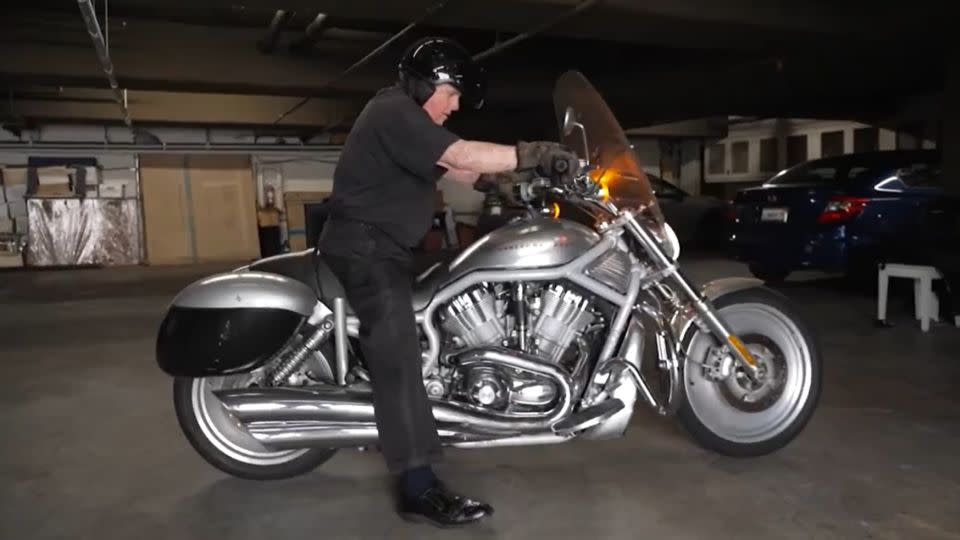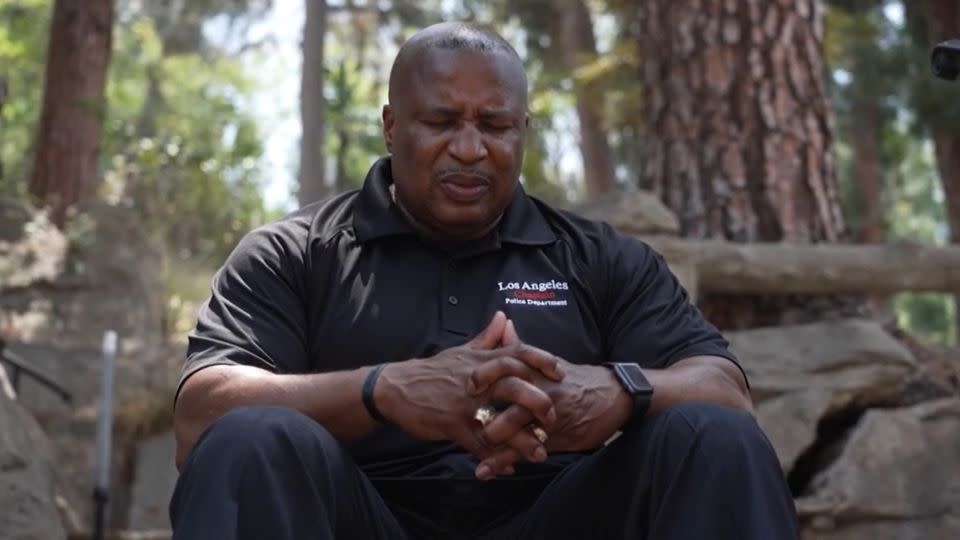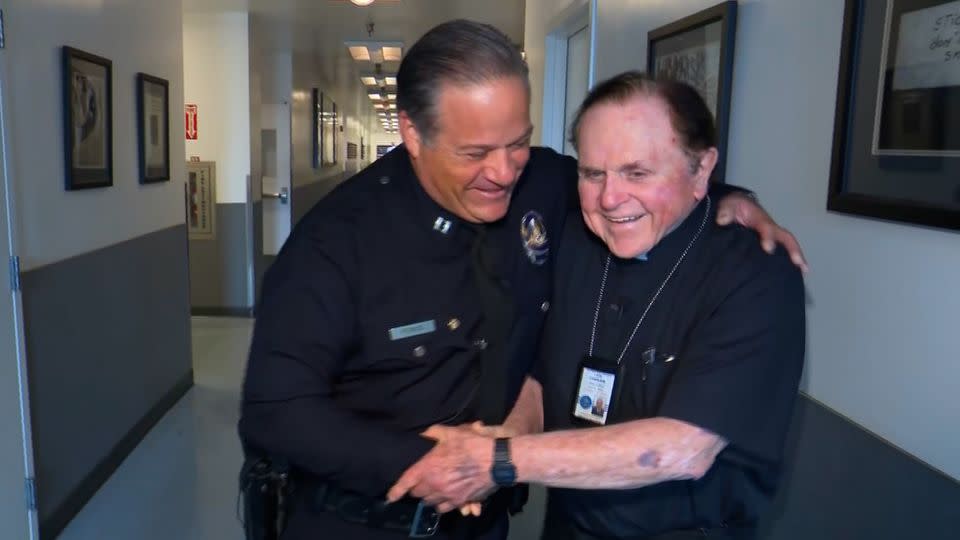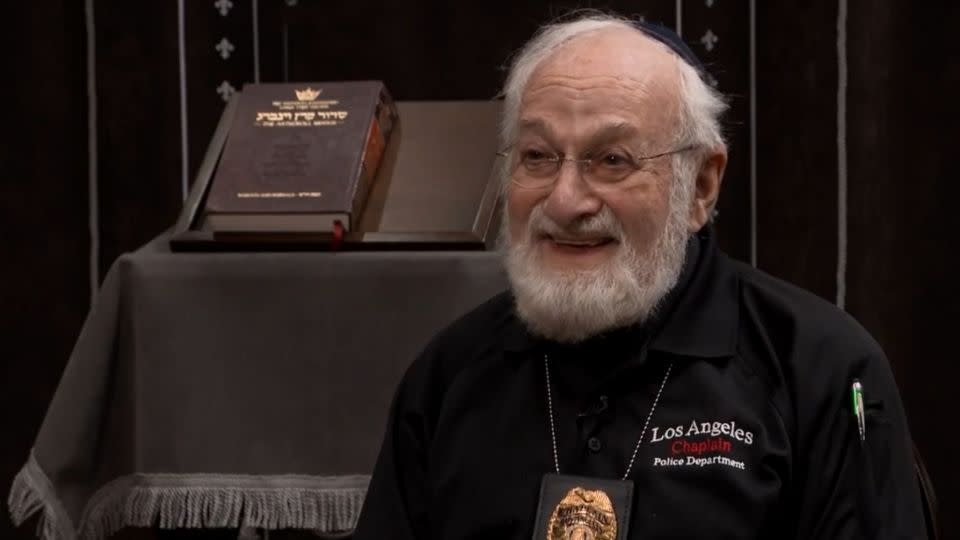A monsignor on a motorcycle, a rabbi who escaped the Holocaust, and priests who pack heat: Meet the chaplains of the LAPD
Dividing time between his parish and his police family in the City of Angels, there’s a monsignor with a motorcycle, a man who’s both devoted to God – and a devotee of Harleys.
Monsignor Frank Hicks revs the engine of his 2002 Harley Davidson V-Rod, the roar echoing through the underground garage of his Los Angeles church like a chrome crescendo.
“There was a retreat for 70 to 80 police officers, and we rode these bikes through the desert to Furnace Creek in Death Valley,” Hicks recalled, gesturing to his other Harleys kept underneath St. Basil’s Catholic Church.
“A monsignor riding a motorcycle is rather unusual, but being with officers in those types of circumstances, you’ll get a much freer interaction.”
Cultivating trust with officers, whether it’s in the Mojave Desert or at an active crime scene, is a key part of Hicks’ position outside parish walls, a crucial component of his mission with the Los Angeles Police Department Chaplain Corps.
The corps enlists 47 chaplains – most of whom are volunteers – representing Buddhist, Catholic, Interfaith, Jewish, Muslim, Protestant and Taoist faiths.

The convergence of religion in a job where trauma is a near-daily occurrence offers a distinct form of counseling, making these chaplains at one of the country’s largest police departments a different kind of first responder. LAPD chaplains work to build trust and break down stigmas around fears and emotions, in a job that has historically viewed such topics as signs of weakness.
Each police chaplain performs a solemn duty: delivering deeply needed solace, spiritual guidance and compassion toward police officers who face relentless pressures and emotional strains.
“My presence among officers means that someone cares, the community cares,” Hicks said. “I see human beings, people who are trying to do their best. And I just want to walk with them.”
Less preaching, more listening
The chaplain corps in Los Angeles mirrors a national trend, as law enforcement agencies turn to chaplains as a supplemental and, advocates say, meaningful part of bolstering resiliency within the ranks.
“Since 2020, we’ve grown to more than 600 chaplains in 32 states,” said Mendy Coën, director general of the United States Chaplain Corps, an organization that trains clergy to serve in police, firefighting, health care and aviation settings.
“There is a burning need for chaplains in police departments across all 50 states,” Coën said. “There’s often a stigma if officers seek help for mental health needs. So chaplains, while they’re no replacement for clinicians, they’re often the first line of defense, a compassionate ear, a confidential source, before the doctors or the E.R.”
In terms of understanding the rigors of the job, 10 of the LAPD chaplains also work cases and patrol the city as sworn officers – pastors who pack heat.
The group of 10 includes the department’s chief chaplain, Officer Kenneth Crawford, who says the duties of chaplaincy are less about liturgy, and more about listening.
“I’m not there to speak sermons to them, I’m not there to try to overwhelm them with whatever I believe theologically,” Crawford said. “I’m there to just be that person who will listen to them, that they can depend on. And hopefully, the experience I have in life and ministry will help them through their difficult times.”
Crawford described police chaplains as sources of light during dark times for law enforcement. In a survey study published in October 2020, 12% of Dallas-Fort Worth police officers reported a lifetime mental health diagnosis. In the same survey, published in the Journal of the American Medical Association, 26% reported current symptoms of mental illness.
From 2017 to 2021, First H.E.L.P., a non-profit that tracks law enforcement suicide data, reported 756 officer suicides. The figure is nearly triple the number of officers who were feloniously, not accidentally, killed in the line of duty during the same time period, the FBI said.

“We chaplains are a human entity. We’re there if officers are overwhelmed with issues personally, professionally, or with their families,” Crawford said.
“[If officers are] avoiding talking about PTSD, if you’re not able to debrief, if you’re not able to talk about it, if you’re not able to process it, those feelings bottle up in you,” Crawford added. “And then it’s one stress on top of another.”
Becoming a cop of the cloth
With incredibly high stakes tied to the mental health of first responders, LAPD officials detailed a multistep vetting process to become a chaplain.
Officer Mike McCarty, a 29-year LAPD veteran who serves as the department’s chaplain coordinator, said candidates are first interviewed by the corps’ eight-person advisory board.
“If a candidate is qualified, and they must be an ordained minister by a credible school, then a background investigation will be conducted by a LAPD officer,” McCarty said. Then a candidate will be assigned to an area for a “two-year probationary time,” he added.
Members of the corps are later issued a LAPD chaplains badge, a uniform, and finally – a bulletproof vest.
The vests are worn when chaplains join officers on patrols, as members of the corps are deployed to hostage situations, crime scenes and fatal vehicle crashes.
“I think if we didn’t have our chaplains, there would indeed be a sense of loss,” said Capt. Aaron Ponce. “And that loss being, an extra layer of resilience, an extra layer of outreach, that extra layer of officers having somebody else who’s familiar with the stresses of law enforcement.”

“This is a different opportunity for our officers to connect,” Ponce added. “Whether it be for spiritual advice, or whether it’s just for a listening ear.”
At a time when law enforcement faces recruitment challenges nationwide, the LAPD chaplain corps has a waiting list of 20 people, officials with the department reported.
The number of chaplains at the department is now the largest among its peer police departments in Chicago and New York – the first and second largest police departments in the country, with Los Angeles following in third. The Chicago Police Department employs six chaplains and the New York Police Department employs 12 within its ranks, spokespersons from both departments confirmed.
Building camaraderie
Perhaps the most essential moments of chaplaincy described by officers and members of the corps are assurances that struggles from witnessing pain and the healing of spiritual wounds are both timeless and can be overcome.
“I approach our solemn duty by trying to talk to officers as if I were their brother,” said Rabbi Israel Hirsch, who celebrated his 90th birthday in October. “I think that’s the most important thing, for officers to know that there’s somebody there who is thinking of them, who is with them.”

Hirsch is a survivor of the Holocaust and a veteran of the Korean War. The nonagenarian is now seen as a fixture within the LAPD’s police station in North Hollywood and says both trust and consequential conversations often come from the genius of a simple overture.
“We schmooze!” laughed Hirsch, reveling in years of swapped stories and precious camaraderie with officers.
“That, in its most essential form, is the best part of being a chaplain,” Hirsch said. “The fact that I can help somebody, see some progress in their demeanor, and see a change for the better in how they look at life.”
In January 2022, off-duty officer Fernando Arroyos was shot and killed while the 27-year-old looked for a new house with his girlfriend. Arroyos was based in the same police station where Monsignor Hicks serves as a chaplain.
“I would say the bulk of the department contacted me personally and wanted to get perspective on it so that they could have some understanding,” Hicks said.
“I tried to impress upon them that, this is a perfect love story,” Hicks offered. “To love someone without having any reservations, to realize their life was important, and that it had been needlessly taken from the community, from their family, and from them.”
As he stood before a portrait of Arroyos in the corridors of the Olympic police station, Hicks said the guidance he offers officers is always ongoing.
“No matter how long that takes, I will be present, I will be available to them.”
For more CNN news and newsletters create an account at CNN.com

